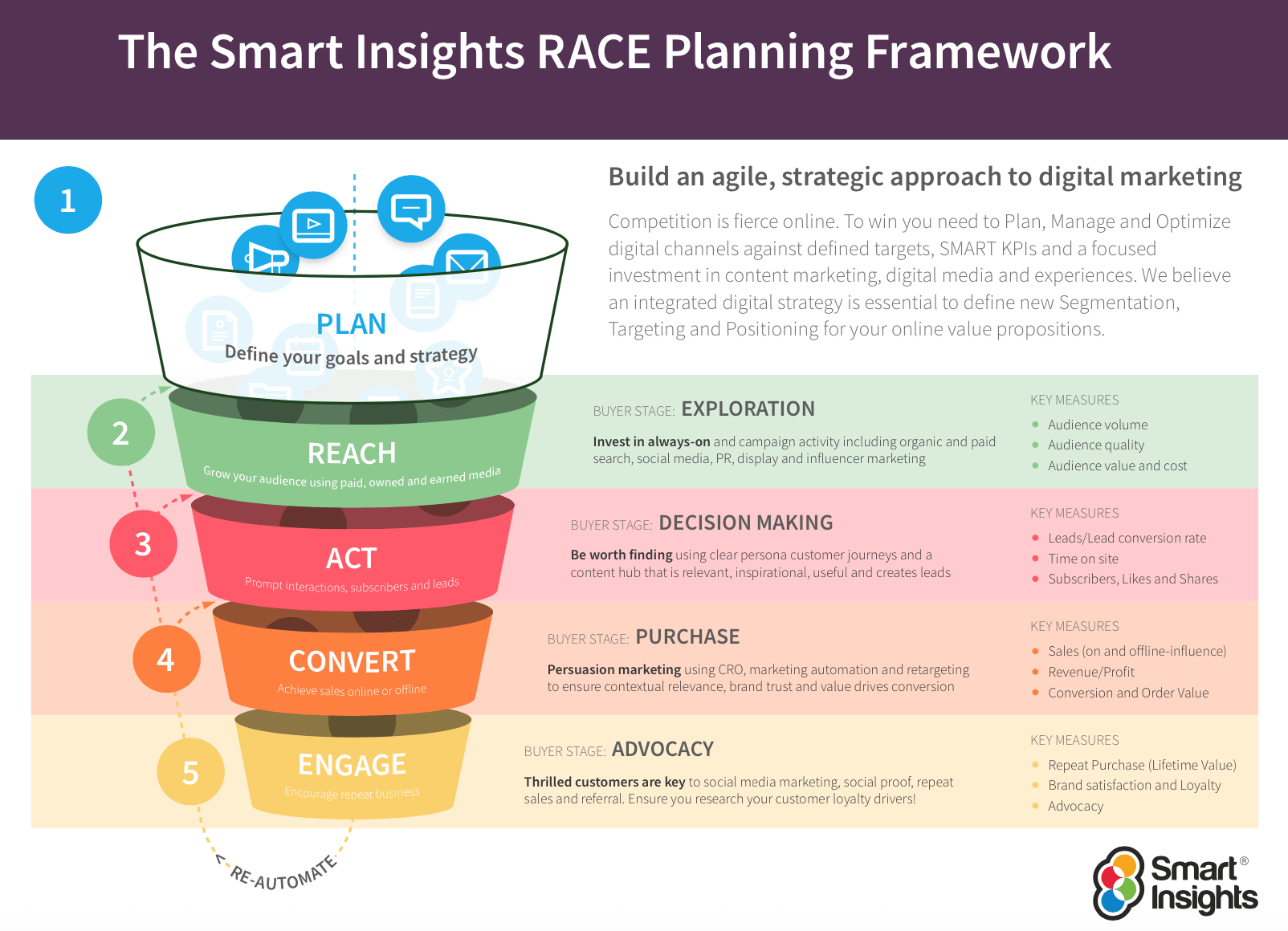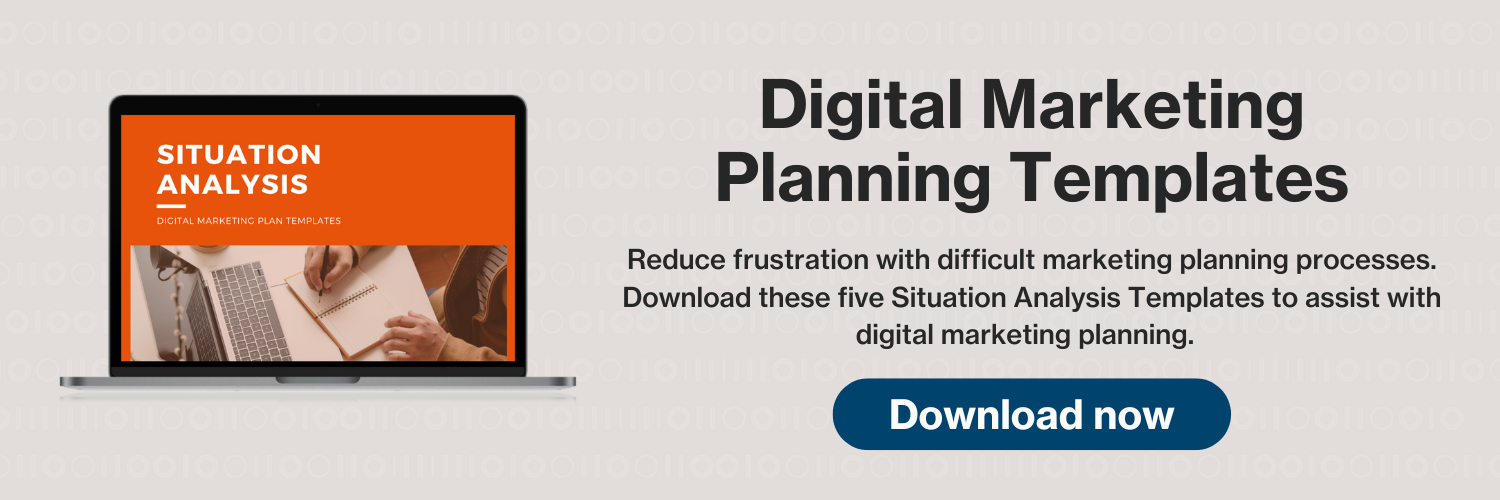The RACE Framework Explained
If you are looking for a framework to organise your digital marketing strategies, the (P)RACE Digital Marketing Framework is what you need. The framework is built on five stages: (Planning), Reach, Act, Convert, and Engage.
The RACE Digital Marketing Framework helps marketers improve the ROI of digital marketing efforts by making sense of the multitude of digital marketing tactics that are available. Created by Dr Dave Chaffey, the framework includes steps to help companies and marketers develop a digital marketing plan that addresses company goals, customer buyer journeys, marketing tactics, and metrics.
For a comprehensive overview of the RACE framework, watch the video below.

Developed by Smart Insights
Mastering Digital Marketing Goals with the RACE Framework
With numerous strategies and frameworks available, it can be overwhelming to determine which approach is best for your business. One framework that has gained significant traction in the digital marketing world is the RACE framework. This framework breaks down the digital marketing journey into four key stages: Reach, Act, Convert, and Engage. In this blog, we will explore each stage of the RACE framework and how it can help you achieve your digital marketing goals. Whether you're looking to build brand awareness, generate leads, increase sales, or build customer loyalty, the RACE framework provides a comprehensive roadmap to success. So, let's dive in and discover how you can leverage the RACE framework to master your digital marketing goals.
Introduction to the RACE Framework for Digital Marketing Goals
The framework is a four-step marketing framework that provides a structured approach to planning and implementing online marketing activities. It was developed by Dr. Dave Chaffey, co-founder and content director of Smart Insights, and is designed to help businesses achieve their marketing goals.
The four stages of the framework are Reach, Act, Convert, and Engage. The Reach stage focuses on building an audience at the top of the marketing funnel. This can be done through various tactics such as search engine optimisation, content marketing, and social media marketing.
The Act, Convert, and Engage stages involve different actions and tactics to move potential customers through the marketing funnel and turn them into brand advocates. This can include activities like lead generation, email marketing, and customer relationship management. The goal is to guide customers through the customer lifecycle and build long-term relationships with them.
By using the framework, businesses can take a strategic and planned approach to their digital marketing activities. It helps them identify the right tactics to use at each stage of the funnel, as well as the key performance indicators (KPIs) to measure success. This framework also emphasises the importance of having an omnichannel communication plan and continuously managing and improving results.
Overall, the framework provides a simple and effective direction for marketing strategy development. It helps businesses align their digital marketing activities with their goals and objectives, and provides a framework for achieving those goals in a structured and systematic way.
Understanding the Reach Stage: Building Brand Awareness and Audience
In the previous section, we discussed the importance of building brand awareness and audience during the reach stage of the customer journey. Brand awareness is crucial for every start-up and company as it determines how familiar your target market is with your brand.
To effectively build brand awareness, it is important to reach the right number of people who fit your target audience. From a digital strategy perspective, this means driving as many unique sessions to your website as possible. Unique sessions on your website serve as a key metric to measure reach, but it is not the only metric to consider.
If you are utilising various types of media, such as paid, owned, and earned media, to build your digital strategy, you should also track metrics like impressions to understand how many people you are able to reach through your advertising campaigns. Additionally, social media plays a significant role in reach, as it allows you to build followers and engage with your target audience.
The reach stage is all about building audience and awareness before moving on to the next stage, which is the act stage. In the act stage, the focus shifts to encouraging user interactions, which can vary depending on whether you are a B2C or B2B brand. For B2B brands, the goal is often to generate leads, while B2C brands aim to engage customers in various ways.
By effectively building brand awareness and audience during the reach stage, you can ultimately boost sales and improve customer loyalty. The framework, developed by Dr. Dave Chaffey and PR Smith, provides a structured approach for planning and implementing online marketing activities throughout the customer lifecycle. It helps marketers set objectives, develop omnichannel communication plans, and manage and improve results for their always-on digital marketing activities.
In the next section, we will dive deeper into the act stage and explore strategies to encourage user interactions and move customers further along the customer journey. Stay tuned!
The Act Stage: Encouraging User Interactions and Lead Generation
In the previous section, we discussed the importance of the Act stage in the customer journey. This stage focuses on encouraging user interactions and lead generation. One effective tool for creating engagement and gathering audience data is quizzes. By utilising a wide range of interaction and question types, marketers can easily create an engaging and interactive experience that encourages users to continue forward.
The goal in the Act stage is to convert visitors into leads. The specific actions targeted for lead generation can vary depending on the type of business. For example, for B2B brands, the focus might be on getting visitors to sign up for webinars or download white papers or industry reports. On the other hand, for B2C brands, the goal might be to get visitors to watch product demonstration videos or engage with product showcases, image galleries, or user reviews on e-commerce websites.
To determine the success of the Act stage, it is important to monitor the number of leads generated. However, to get a more granular understanding, it is also crucial to track the visitor to lead conversion ratio. For instance, a B2B website might have a visitor to lead conversion ratio of 1.5%, meaning that for every 1,000 visitors, 15 leads are generated. This ratio can provide insights into the effectiveness of different tactics and optimisation efforts.
Conversion rate optimisation and optimising the user journey are key tactics to increase the visitor to lead conversion ratio. This involves looking at landing pages, form designs, and overall user experience to reduce friction and make it as easy as possible for users to complete the desired action. By continuously improving the user journey, marketers can increase the number of leads generated and move users further along the buyer decision-making journey.
In summary, the Act stage is all about encouraging user interactions and lead generation. By utilising tools like quizzes and optimising the user journey, marketers can successfully convert visitors into leads and move them closer to making a purchase or taking the desired action.
The Convert Stage: Optimising the Conversion Process and Increasing Sales
In the marketing and sales funnel, the conversion stage is a crucial step where prospects transition into paying customers. While the marketing and sales funnels share similarities, there are some key differences in how the conversion stage is defined.
In the marketing funnel, the conversion stage typically marks the end of the funnel when a site visitor signs up for a product or service, or completes a free trial. On the other hand, the sales funnel is specifically designed to turn leads into paying customers. This means that one of the main objectives of the marketing funnel is to convert Marketing Qualified Leads (MQLs) into Sales Qualified Leads (SQLs).
The conversion stage focuses on optimising the purchase process and increasing conversion rates. For e-commerce platforms, this can involve streamlining the user journey by reducing the number of screens and clicks required to complete a transaction. Tactics like offering relevant product recommendations and simplifying the checkout process can help improve the conversion rate.
In more complex sales situations, such as business-to-business transactions that may take months to complete, additional strategies like marketing automation, CRM, and ongoing engagement are necessary to convert leads into sales. These tactics require a more personalised and targeted approach to nurture leads and build relationships.
Key performance indicators (KPIs) for the conversion stage include measuring the total number of sales generated, the revenue generated, and increasing the basket size of each purchase. E-commerce platforms often use tactics like upselling and cross-selling to encourage customers to add more items to their cart before checking out.
After the conversion stage, the next step is the engage stage, where the focus shifts to building loyal customers and increasing customer lifetime value. Key metrics for the engage stage include measuring customer lifetime value and net promoter score, which reflects customer satisfaction and loyalty.
By optimising the conversion process and increasing sales, businesses can create a solid foundation for building long-term customer relationships and maximising the value of each customer.
The Engage Stage: Building Customer Loyalty and Advocacy
The Engage stage is a crucial step in building customer loyalty and advocacy. During this stage, you have successfully captured the attention of potential customers and they are actively engaging with your brand.
To increase customer engagement during the discovery stage, it is important to focus on your SEO strategy. By optimising your website and content for relevant keywords, you can ensure that your brand is easily discoverable and that potential customers can find the information they are looking for. This will make a great first impression and increase the likelihood of further engagement.
Capturing feedback from customers is another important aspect of improving customer engagement during the discovery stage. One popular method is to use the Net Promoter Score (NPS), which measures customer satisfaction and likelihood to recommend your brand to others. By understanding how satisfied your customers are and their willingness to refer you, you can identify areas for improvement and tailor your messaging to better resonate with your target audience.
Building a dashboard with key metrics can provide valuable insights into the quality of customer engagement during the discovery stage. Metrics such as bounce rate, visitor to lead conversion ratios, and average transaction value can help you understand how effectively you are engaging with your audience and identify areas for optimisation. By regularly monitoring these metrics, you can make data-driven decisions to improve engagement and drive better results.
Ultimately, the goal of customer engagement is to turn customers into long-term advocates for your brand. By providing a positive and personalised experience during the discovery stage, you can build trust and loyalty, increasing the likelihood that customers will continue to engage with your brand and recommend you to others.
To achieve this, you can leverage the framework, which provides a structured approach to planning and implementing your digital marketing activities. The framework, developed by Dr. Dave Chaffey and PR Smith, consists of four stages: Reach, Act, Convert, and Engage. By following this framework, you can create omnichannel communication plans, manage and improve results, and ensure that your digital marketing activities are always-on and aligned with your overall marketing goals.
In Short
The framework offers digital marketers and strategists a clear and structured approach to achieving their marketing goals. By understanding and implementing each stage of the framework - Reach, Act, Convert, and Engage - businesses can effectively build brand awareness, generate leads, increase sales, and build customer loyalty. With the ever-evolving digital landscape, it is essential to stay ahead of the competition and adapt to changing consumer behaviors.
The framework provides a roadmap for success, allowing businesses to navigate the complexities of digital marketing and achieve their desired outcomes. So, whether you're just starting out or looking to optimise your current digital marketing strategy, the framework is a valuable tool to master your marketing goals and drive success in the digital realm.

Comments